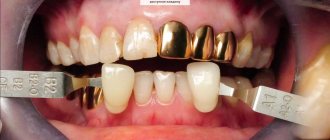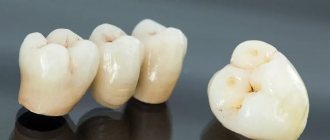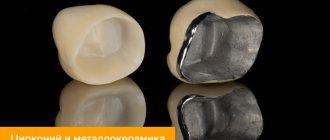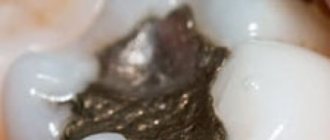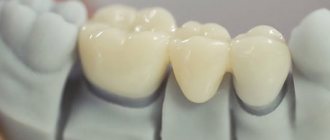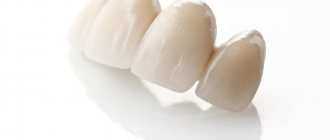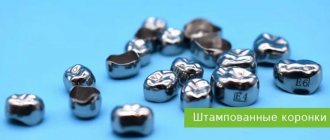KHS, prosthetics
Clasp dentures
We will try to dispel myths and idle speculation regarding the use of titanium in dentistry. The first thing you need to understand is that titanium is not an alloy (often said to be a titanium alloy), it is pure Ti
number 22 on the periodic table. It is pure titanium that has taken a strong place in surgery and dentistry. Many people know how this unique metal is used in reconstructive surgery - plates for the skull, pins for repairing bone fractures, artificial joints - the femoral neck, for example. As you can see, titanium has taken a strong place in the human body and has proven itself to be biocompatible. Titanium has been used in orthopedic dentistry for quite some time. This was due to technical difficulties when working with this metal and therefore less “capricious” materials were used everywhere - stainless steel, alloys of cobalt, chromium, nickel, gold.
Titanium Discovered in 1789 by Klaproth, titanium did not find practical use for a long time due to its fragility. The purest titanium obtained in 1925 by Van Arkel and de Boer using the iodide method turned out to be a ductile and manufacturable metal with many valuable properties that brought it to the attention of a wide range of designers and engineers [2].
For reference. In 1953 A.I. Doinikov et al. A cobalt-chromium alloy (CHS) has been developed and produced. The alloy is based on cobalt, which has high mechanical properties. Chromium is used to give the alloy hardness and anti-corrosion properties. Molybdenum gives the alloy a fine-crystalline structure, which enhances the strength properties of the alloy. Nickel increases the toughness of the alloy. Molybdenum in small quantities improves the quality of casting, improves fluidity, lowers the melting point, and helps remove gases and sulfur compounds. The iron admixture is no more than 0.5%, since it increases shrinkage during casting and worsens the physicochemical properties of the alloy [1].
Traditional alloys An alloy of biologically incompatible metals, and currently the focus is on the issues of biological compatibility and bioadaptation of alloys.
Indications for installation
An alloy of chromium and cobalt is used for the manufacture of various types of prostheses - bridge crowns, clasp and conventional systems, abutments. Today, the material is used less frequently, due to the advent of more modern materials that have increased strength and provide excellent aesthetics.
Indications for installing structures made of cobalt-chromium alloy are:
- it is necessary to restore the crown part in case of severe tooth decay;
- the tooth shape is abnormal;
- enamel wear is pathological;
- there are cracks and chips caused by injuries, impacts;
- fluorosis from an advanced stage.
Bridge crowns are installed in the form of a structure made of alloy and high-alloy steel in case of partial edentia, that is, the loss of several units located nearby in one row. Also, such designs are chosen when it is impossible to install prostheses made of other materials, during planned replacement.
Not used in the following cases:
- the coronal part is small;
- there is an allergic reaction to alloy components;
- periodontal disease, supporting units are loosened;
- advanced form of malocclusion;
- dysfunction of the mandibular joint;
- stomatitis, gingivitis in the acute stage.
Titanium alloy crowns
Advantages of titanium crowns
Titanium has been successfully used in dental and orthopedic practice over the past decades. Alloys based on this metal have:
- highest biocompatibility,
- ease,
- strength and reliability.
Dental prosthetics using titanium crowns are suitable for people suffering from allergies: the material never causes hypersensitivity reactions.
In addition, such prosthetic structures are low in cost compared to their analogues, although they are somewhat inferior to the latter from an aesthetic point of view.
Titanium-based carbide crowns last up to 15 years.
Disadvantages of titanium crowns
At the same time, crowns made of titanium alloys also have a number of negative features. Thus, due to the high complexity of the material processing process, prosthetic structures very often turn out to be inaccurate and require additional adjustment. In addition, ceramic coating on titanium frames does not adhere very well, so special ceramic masses that have an unnatural and unaesthetic grayish tint are used as a decorative and protective coating.
Since all materials used for the manufacture of carbide crowns have a number of disadvantages, modern scientists continue their work to improve their quality and consumer properties. To give prosthetic devices a more natural look, dental clinics use titanium-zirconium and titanium nitride protective and decorative coatings, plastic or ceramics.
Characteristics of materials for prostheses
Cobalt-chromium alloys are used in prosthetics along with other materials. The components of such prostheses have the following characteristics:
- cobalt – content 66-67%, high mechanical properties;
- chromium – content up to 30%, provides strength, structural hardness, resistance to oxidation and corrosion;
- nickel – content up to 5%, ensures plasticity and malleability of the material during manufacturing;
- molybdenum – content up to 5%, increases the strength of the product, casting quality, is used to simplify processing;
- carbon - used to impart fluidity to the alloy and reduce the melting point.
Silicon (up to 0.1%) and nitrogen (up to 1%) may be present in small quantities. For prosthetics manufactured in the Russian Federation, gallium and beryllium are not included in the alloy composition (due to high toxicity). But in the USA, such components are mandatory, which negatively affects health.
Nickel-chrome dental crowns
Types of chromium-nickel crowns
Chromium-nickel stainless steel is a hard alloy whose main components are nickel, chromium and iron. In modern dental practice, several varieties of this material are used:
- 1Х18Н9Т (shiny alloy used for the manufacture of blanks (sleeves) for stamped dental crowns);
- EI-95 (material used for the manufacture of cast crowns);
- "Dentan" (an alloy with a high nickel content and a reduced iron content).
- Chromium-nickel alloys are easily stamped, soldered and almost do not wear out.
Disadvantages of chromium-nickel crowns
However, such materials also have a number of significant disadvantages. These include:
- discrepancy between the color of prosthetic devices made of chromium-nickel alloy and the color of natural dental crowns;
- too much weight of finished prosthetic devices;
- high percentage of alloy shrinkage (3-5%);
- high melting point;
- increased risk of oxidation of the prosthetic device and the appearance of an unpleasant metallic taste in the mouth.
In addition, the material is a common allergen, which means that dental prosthetics using it can cause the development of hypersensitivity reactions in dental clients suffering from allergies.
Manufacturing of the structure
The manufacture of alloy prostheses requires several steps. At the first stage, a preliminary consultation, examination, and additional research are carried out. In preparation for prosthetics, inlays or pins are installed, and the remote control is devitalized to avoid complications. Based on the impressions, the design of the crowns is made, which are installed on the prepared row.
Advantages and disadvantages
Advantages:
- For production, safe, hypoallergenic raw materials are used that do not have a negative effect on fabrics;
- the products hardly shrink, the finished structure retains shape stability and does not deform;
- with proper care, the surface of the structure does not fade or darken;
- the cost of prostheses is low.
Flaws:
- the risk of developing galvanic syndrome, the appearance of an unpleasant aftertaste, discomfort;
- aesthetics are poor, so cobalt and chromium structures are used to replace side units;
- With prolonged wear, there is a possibility that the gum color will change (a characteristic bluish tint appears).
Operational terms
Depending on the class of prostheses, the service life is 10-20 years. Most experts recommend replacing designs every ten years. This is due to the fact that gum tissue undergoes natural changes with age, and the edges of the structure may become exposed. The service life of prostheses is also influenced by the following factors:
- frequent consumption of solid foods;
- inflammatory processes of soft tissues, infectious gum diseases;
- failure to comply with hygiene rules;
- low quality prostheses have a short service life.
Features of care
After installation of structures, daily care is required, which is practically no different from cleaning natural teeth. You should use brushing twice a day, using pastes and rinses. After each meal, you can additionally use elixirs that eliminate food residues and unpleasant odors.
To maintain the light shade of the crowns, it is recommended to limit coloring foods, for example, tomatoes, beets, coffee. You should also avoid rough foods, which can cause chipping. Nuts, crackers and other solid foods should be consumed rarely or completely excluded from the diet.
Every six months you should visit a doctor for a preventive examination. Periodically undergo professional cleaning of enamel from plaque and stone.
Common parameters
Each alloy option for dental prostheses has its own composition; manufacturers often use their own developments and combinations.
The main thing is to bring the composition and characteristics of the substance to a certain standard and obtain a combination of certain qualities:
- safety. The metal must be absolutely safe, maintain its parameters and not emit harmful compounds during operation;
— corrosion resistance. Raw materials must resist corrosive processes, which eliminates oxidation and related problems throughout the entire guaranteed service life;
- strength. Components made from an alloy must withstand significant variable and static loads, such as compression, bending, and methodical movements in a certain direction;
- aesthetics. The use of parts should not come at the expense of appearance; first of all, it is necessary to recreate the appearance of natural units and obtain acceptable operational parameters;
- availability. This version of prostheses, although inferior to others in a number of aspects, surpasses them in the combination of price and quality. For example, the products are aesthetically comparable to zirconium dioxide, but the price tag is several times lower.
The alloy is non-toxic, but during service, especially if the processing features, recommended composition or care are not followed, they can release components that provoke reactions in the body. Because of this, the designs are considered more allergic and will require a comprehensive examination in the dentist's chair before choosing this type of denture.
The metal resists corrosion for a long time, but can cause another negative effect - a galvanic reaction. It can only be provoked by the presence of artificial components made of another metal, in particular stainless steel, in the oral cavity. Therefore, before carrying out operations, you need to make sure that no conflict will arise. Often in this case, existing elements are replaced with ones similar to those being installed.
The strength of the alloy is maintained only under strict compliance with the processing conditions, composition and recommended parameters of the implanted elements. You can get a low-quality product due to the negligence of the technician or the company producing the blanks. In the second situation, problems most often arise when purchasing blanks from untested and little-known companies. You can navigate by price; high-quality ones cannot be too cheap, but there is no point in purchasing prohibitively expensive ones.
Metal ceramics are one of the examples of the best products in terms of compliance with natural units. Components (crowns) are obtained by layer-by-layer application of a ceramic composition to the alloy surface. Due to the possibility of color adjustment, it is possible to bring products into full compliance with natural teeth, either preserved ones, or to fulfill non-standard wishes of the client.
Material forms
- Ingots weighing 7-10 g. Produced by casting in an atmosphere. Disadvantages include casting defects due to the increased gas content.
- Rods. The molten metal is sucked into metal or quartz tubes, acquiring their shape as they solidify. Subsequently it is cut into cylindrical blanks. This is the most common manufacturing method
- Discs of various diameters and thicknesses. Manufactured in induction vacuum installations. Used for the manufacture of prosthetic structures using CAD/CAM technology.
- Granules. It is obtained by pouring the alloy into a liquid.
Physical and chemical properties
The set of alloy parameters completely depends on the constituent elements.
In the case of dental cobalt chromium, these are the following components:
- base in the form of cobalt. The element must be at least 66-67 percent; it is responsible for the increased mechanical properties of the resulting metal;
- chromium is in second place, it should be at least 26-30 percent. The component is responsible for increased hardness and improved resistance to oxidative processes and corrosion;
- Nickel is the third most important, it is responsible for increasing technological parameters. At a percentage within 3-5 percent, the material becomes more malleable, ductile and viscous. Aspects make it possible to obtain a simpler substance in terms of release;
— molybdenum gives the structure a fine grain, which has a positive effect on the strength characteristics. The element can be added no more than 4-5.5 percent;
— manganese serves to solve a whole range of problems. Firstly, it increases the strength parameters of finished products. Secondly, the quality of casting increases due to the modernization of the alloy structure. Thirdly, the melting point of the substance drops noticeably, which is beneficial under production conditions and subsequent processing. Fourth, sulfur compounds, which are considered toxic to humans, are removed.
Two more components that can be found in blanks are beryllium and gallium. The problem is that the components are toxic and during operation can release a large amount of harmful substances, some of which can be accumulated by the body. The production of such products is carried out only by the USA, adding within 2% to the composition for the purpose of alloying it. You won't find such products in Europe.
These first three elements are the main ones, thanks to them the alloy matrix is formed, therefore cobalt-chromium-nickel should be at least 85%. The data is fixed by an international standard, therefore, when purchasing a workpiece of any brand, you can expect consistently high quality and similar characteristics. If components break during molding, the chromium content threshold of 30 percent is most likely exceeded, which causes the alloy to become brittle and the mechanical and casting parameters to drop.
This is interesting: How to eliminate odor from under a tooth crown: what to do
Another important element is carbon, however, it is not found in all products. Its positive quality is an increase in fluidity in the molten state and a decrease in the melting point.
Nitrogen and silicon have a similar effect, but they need to be added in a very small percentage:
- no more than 0.1 percent for the first;
- up to 1% for the second.
If this threshold is exceeded, plasticity will suffer.
The downside of carbon is that it can damage the ceramic layer during the release process of the prosthesis. During high-temperature firing, it can be released in the form of gas, entering the lining. Because of this, bubbles appear at the junction of metal and ceramics and the connection between the components weakens, reducing the service life and reliability of the finished oral element.
Due to these weaknesses, a number of companies, including many domestic ones, are engaged in the production of carbon-free billets.
If the composition is observed, the finished material has a mechanical viscosity twice that of gold. Metal melts at more than 1450 degrees.
What is made from CHS
The following are made from CHS:
1. Crowns.
2.Bridges.
3. Prostheses.
4. Implants.
Let's look at each product separately.
Crowns
Crowns are cap-shaped microprostheses that completely or partially cover the coronal part of the tooth. They are used for defects that cannot be eliminated with onlays, inlays or fillings . That is, when the degree of destruction exceeds 50–80% of the crown part of the tooth.
A KHS crown can consist of one metal or be a metal frame coated with ceramics, plastic or powder coating.
Metal-ceramic crowns (KHS, bioalloy)
Metal-ceramics is one of the types of dental prosthetics that can solve many problems associated with the restoration of damaged and lost teeth. Thanks to the metal base, this type of tooth reconstruction is very durable and allows you to restore chewing function in full. The reliability of the design ensures long-term use. Ceramics, in turn, allows you to achieve a natural look and recreate the natural shape and color of the tooth. Metal ceramics are made individually and follow the contours of the dentition. The appearance of the metal-ceramic crown is maintained throughout the entire period of operation.
Solid crowns (KHS)
A solid crown is a metal crown that is made from a cobalt-chromium alloy using the modern solid casting method. This method assumes that the entire structure is cast simultaneously. In the case of making bridges, this completely eliminates the need to solder crowns to each other.
Bridge prostheses (BDP)
Bridges are installed when there is a defect of no more than three teeth in the chewing area or 4 in the frontal area. As a rule, the MVP frame made of cobalt-chromium alloy is made by casting. This ensures the accuracy of the design.
The advantages of such prostheses include high strength, rare cases of individual intolerance (compared, for example, with nickel-chrome frames), and cost-effectiveness.
The main disadvantage of bridges is the need to grind the teeth (reducing their service life), and overloading the supporting units, which sometimes leads to the destruction of their periodontium.
Removable clasp dentures
Cobalt-chrome is considered the best material for making the frame of arched prostheses, due to its strength, compactness, durability and cost-effectiveness. The structure is made by casting.
Superstructures for implants
The orthopedic part of intraosseous implants, made of cobalt-chrome and lined with ceramics, provides a clinical effect comparable to gold alloys.
The processing process and its subtleties
One of the methods of material processing is casting. The technology has been tested on dozens of alloys with different properties, allowing us to obtain high-quality products with a homogeneous structure.
To create the frames of removable, fixed and partially removable dentures, which are produced on the basis of an alloy, crowns, the casting method is used; using a similar technology, blanks for milling are obtained, for example, pre-milled abutments.
This is interesting: Acetal prosthesis: advantages and disadvantages, reviews, types of design
When casting, crucibles made of refractory material are used, which, in a prepared state, are loaded into an induction installation for the corresponding tasks. Melting is carried out to fill the prepared forms, the material turns into a liquid state and burns out the components of the models.
To do this, it is necessary to heat the metal elements to 1315 degrees, at which point its transition to a liquid state begins. At this stage, it is important to avoid overheating; in this case, the alloy alloy may burn out, so at the first sign of a change in shape, the technician starts the foundry unit.
It is important to fully maintain the set temperature level during the process. If overheating occurs, the structure becomes contaminated with oxidizing impurities. An experienced technician will immediately identify such discrepancies, since the processing crucible will be contaminated by the specified oxides after melting the workpieces. The absence of these elements and the cleanliness of the crucible is evidence of the high quality of the resulting product. In this case, the physical and chemical characteristics are not distorted, which has a positive effect on service life and reliability.
The prepared parts need to be processed; if all stages of the technical process are followed, then the stage takes a minimum of time. There will be no need to remove sagging, deformations and adjust the product to the required shape. Sandblasting occurs (aluminum oxide is used as a harder and finer-grained composition, giving maximum surface quality) and polishing.
Initially, sprues, flash marks and similar foreign components are removed. It is important to pay attention to the presence of visual defects on the internal surfaces of the metal structure, such as burrs or pearls.
Stages of creating dentures and crowns
The procedure for prosthetics depends on the type of prosthesis and the chosen manufacturing technology, which may differ for the same source material (casting, stamping, milling).
Let's consider the simplest option - manufacturing a metal-ceramic crown with a cobalt-chrome base using casting and sintering of ceramic mass.
The process consists of the following clinical and laboratory steps:
- Making a diagnosis, drawing up a treatment plan (examination and interview of the patient, radiographic studies, selection of prosthesis design).
- Grinding a tooth for a crown.
- Taking an impression of the prepared tooth and its antagonists.
- Making a plaster model based on a cast.
- Wax modeling of a metal frame.
- Crown casting.
- Fitting it to the tooth, finalizing it.
- Selecting the color of ceramic cladding.
- Installation of a metal frame on a tooth model, application of ceramic mass in layers, sintering in an oven.
- Trying on a finished crown on a tooth, modification if necessary.
- Glazing, finishing.
- Fixing the crown on the tooth with cement.
In some cases, at the request of the patient, a provisional (temporary) plastic crown is made and installed while the permanent crown is being manufactured. But this is not always done.
The video shows the process of welding a denture made of cobalt chromium.
